Everything You’ll Ever Need To Know About Microfiber Performance Fishing Shirts!
- By: Joseph Simonds
- on
- Found In: Product Reviews, Salt Strong
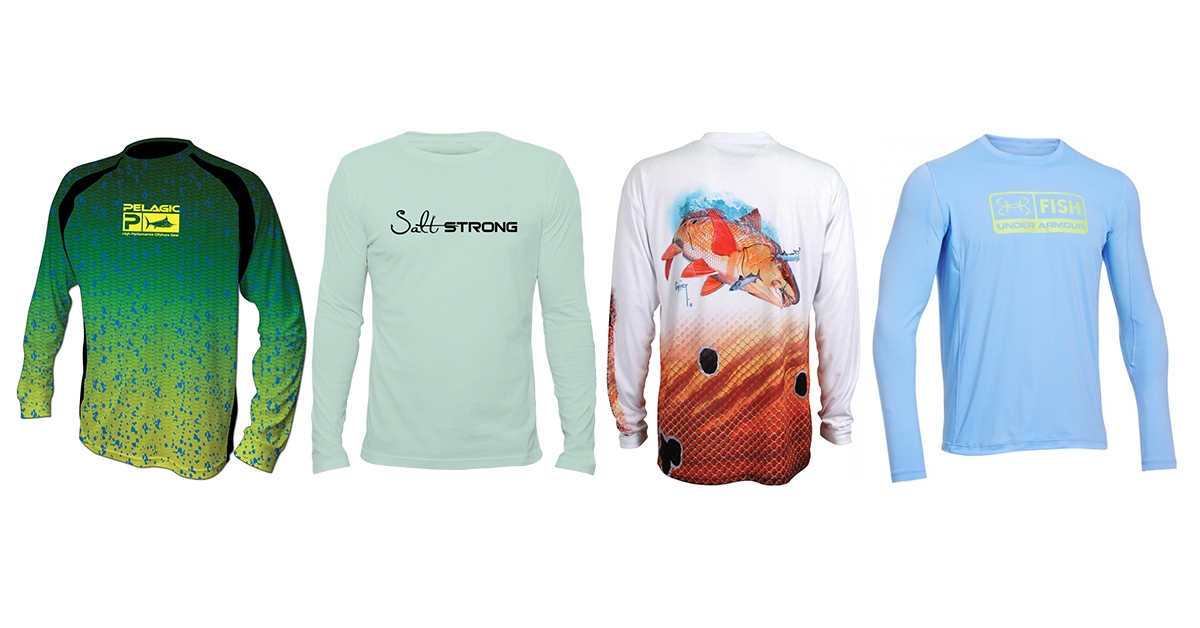
You’ve finally found it…
A consumer’s guide to buying the best microfiber performance fishing shirt for your money.
I’m about to share with you EVERYTHING that I have learned (even the bad stuff) about these performance fishing shirts over the past 14 months in this single guide.
A guide that will help you:
- Know exactly what to look for when purchasing a performance fishing shirt for yourself or your family members/friends
- Avoid the biggest mistakes that people make when buying microfiber performance fishing shirts
- Know exactly how much you should pay, and what to expect in terms of actual “performance” and longevity
- Get the biggest bang for your dollar and give you leverage and power as a consumer
Let’s start with the basics first…
What Is A Microfiber Performance Fishing Shirt?
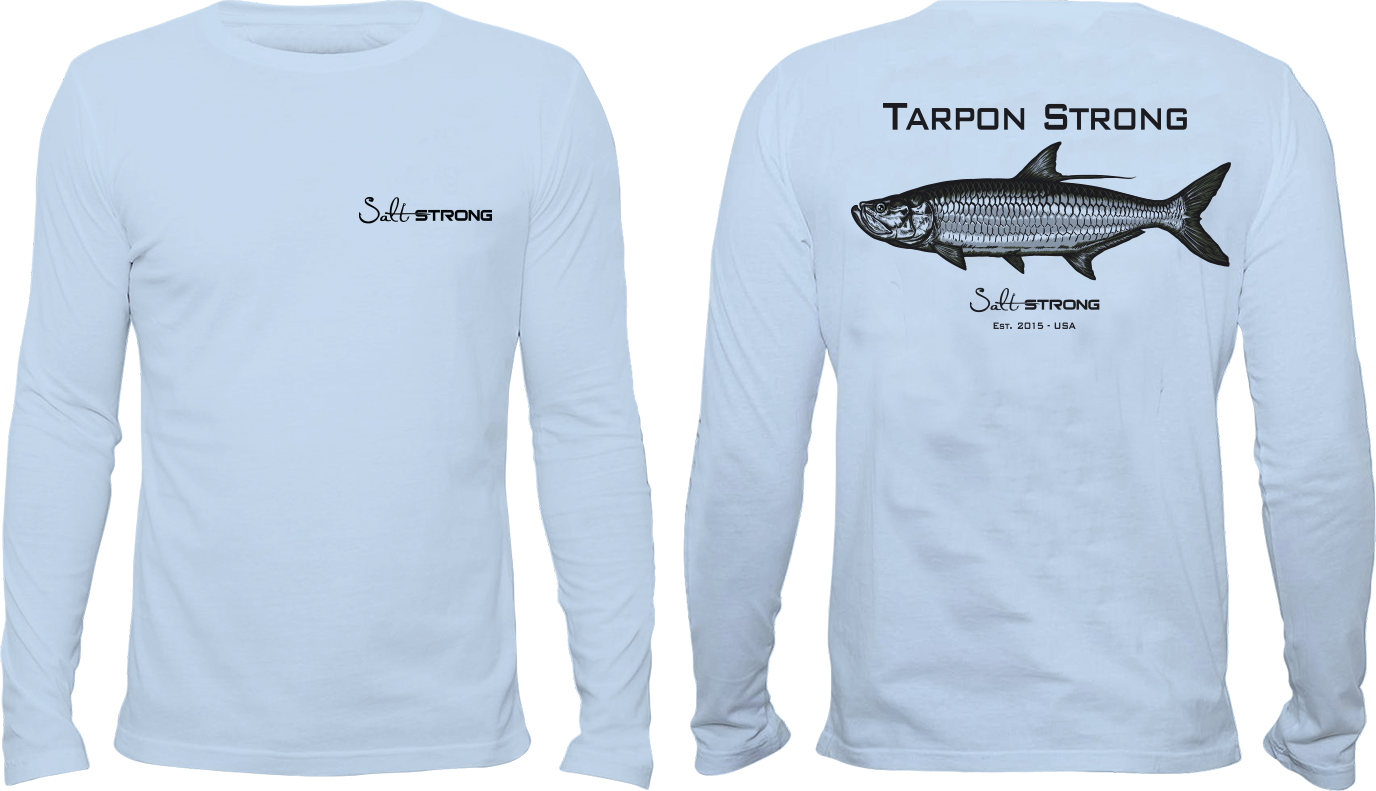
If you’ve spent any time looking at saltwater fishing apparel over the past couple of years, you can’t help but notice the explosion of these “Microfiber Performance Fishing Shirts”.
Walk into any big box outdoor or fishing retailer like Bass Pros Shops, Dicks Sporting Goods, and Cabellas and you see a vast array of different brands, different designs, different colors, and even different prices for these popular fishing shirts.
We aren’t sure exactly who came up with very first performance fishing shirt (although Columbia was the first to nationally promote and brand the PFG “Performance Fishing Gear” line of fishing shirts – of course, those popular Columbia fishing shirts with the vents in the back are a completely different animal than the microfiber shirts that we will be talking about here), but one thing we know is that these fishing shirts are a must-have for any angler that spends time out on the water.
So what is it?
Although there isn’t an exact definition that we’ve been able to find, these performance fishing shirts usually have the following characteristics:
- Made from some blend of synthetic polyester
- Lightweight
- Have a UPF Sun Protection rating anywhere from 15 to 50+
- Have been called “Dri-fit”, “Microfiber”, “Performance Gear” or “Sun Shirts” (they all mean the same thing)
- Can come in long-sleeve or short-sleeve
- They are designed to be soft, breathable, moisture-wicking, sun protecting shirts for the outdoors
So now that you know what a microfiber performance fishing shirt is, let’s discuss all of the critical things you should look for when buying one.

1. Cost
Why wait until the end of this guide to address what most of you want to know right now… the cost.
Let’s talk about the following in regards to the cost of these microfiber performance fishing shirts:
- How much should you be willing to pay for a fishing shirt?
- Why some shirts cost more than others?
- The truth about buying your performance fishing shirts at retailers.
When my brother Luke and I entered the saltwater fishing apparel world a little over a year ago with Salt Strong, we were blown away with what I am about to share with you…
We were shocked to learn that:
- None of the fishing shirt makers own their own manufacturing facilities so none of them really have anything that proprietary except for the design.
- But even more shocking is that many of the leading performance fishing shirt companies are using the exact same shirt manufacturer, exact same materials, etc. Meaning, the only thing really different in many of these performance fishing shirts is the design, the brand (how much the logo means to you), how many middlemen are in between you and the company, and the final cost to consumer…
Earlier this year I was reading one of Daymond John’s (from the hit show Shark Tank) books, and he told of a similar story when he was building the urban brand “FUBU”.
He said he was shocked to find out that he was sharing the exact same manufacturing facility as big names like Tommy Hilfiger, Gap, etc.
In other words, they were all using the same people, same assembly lines, and even many of the exact same materials to make a lot of the big named brands that we all know and love.
I know what you are thinking right now…
So if that is the case, why is there such a cost difference in these microfiber performance fishing shirts if many of them are basically the exact same shirt (minus the design and logo)?
For instance, we’ve seen some for as low as $27, while others as high as $60!
Unfortunately, there is no one single answer, but you can boil it down to these three topics:
- The Retail Effect
- The Brand Value
- Quality & Customer Service
The Retail Effect
I was watching a recent CNBC interview with Jason Hairston, the CEO of the hunting apparel company KUIU, where he was exposing the big box stores, the mid-size stores, and even the specialty stores that he used to work with in his old apparel business.
In this interview, Jason revealed the following:
- Most brands charge an approximate 100% markup on their goods regardless if they are selling direct to the public, to a middleman, or to a big box retailer. For instance, if XYZ company can get their shirts made for $15 from their manufacturer in China, then they will sell those shirts for approx $30 to ABC (consumer or middleman).
- Jason went on to reveal (and this is why he started his direct to consumer hunting apparel company) that the big box retailers and specialty stores tack on ANOTHER 100% markup when they sell it to you. So if XYZ company gets the shirt for $15, they sell it to the big box retailer for $30, and then the big box retails charges $60 to the consumer.
In other words, you could be paying upwards of double the price at a big box retailer or specialty store than you would had you bought direct from the brand.
So why don’t all brands just go direct to the consumer and give better prices?
It’s really hard to compete with the foot traffic, the exposure, and the reach that a big box retailer has with consumers.
Not to mention, most apparel brands have no idea how to market and scale a business that is direct to consumer or 100% online.
The good news (for you, not the fishing brands) is that many of the big box retailers squeeze some of the profits out of the brand so that you aren’t paying the full $60 on a $15 shirt in my example above, but nonetheless, it is still well above what you would pay if you were able to go direct to the brand that made the shirt (aka cutting out the middleman).
Economies of Scale
Now it wouldn’t be fair to not point out that many of these fishing brands that distribute their performance shirts through the traditional retail network don’t get some good overall pricing due to economies of scale, because they certainly do.
For instance, a brand that might sell 250,000 performance shirts in a year will certainly be able to make their shirts cheaper than a brand that only sells 2,500 in a year, even if they both use the exact same manufacturer.
Will it be 50% less to offset the retailer’s additional expense to you?
Of course not.
But it could still be substantial dollars that come out of the equation.
The Brand Value
While discussing cost, it is impossible to ignore brand value.
What is brand value?
It’s the perceived value of the brand in the eye of the consumer.
For instance, in the car world, a Mercedes-Benz C-Class has a higher perceived brand value than a Ford Focus, regardless of the fact that they are both cars that get you to and from point A to B.
In the apparel world, Polo shirts by Ralph Lauren have a higher perceived brand value than a polo shirt by Lands End (even though the shirt is almost identical in some cases, minus the Ralph Lauren Polo logo).
So there is certainly some cost fluctuations that occur in these performance fishing shirts in regards to brand value, regardless if people admit it or not.
Quality & Customer Service
The rest of this guide will cover different aspects of quality that you should look for in your shirts.
And quality (combined with good customer service) certainly plays an important role in the ultimate cost of a shirt.
For instance, I would gladly pay more for a high-quality shirt that ships on time where I know I can email or call to speak with someone if I have an issue or have to make a return.
On the other hand, I personally stay away from any brand that has low quality and no customer support…
In fact, I wish they all went out of business so it would be easier for all consumer’s to have better experiences when purchasing apparel… but that’s a different blog post.
2. “Permanent Design”: Sublimation vs Screen Printing
A few weeks ago, I posted an eye-opening blog (and video) discussing the difference between sublimation printing on polyester performance fishing shirts vs screen printing on polyester performance fishing shirts.
Note: You can see the full post and video by clicking here
If you missed it, here was the consensus:
Screen printing DOES NOT ever belong on microfiber performance fishing shirts for the following reasons:
- Screen printed designs are hot while out in the sun (because each color can be an extra layer on your shirt)
- It doesn’t breathe (screen printing is layers of ink which are not breathable)
- It gets sticky and annoying (you’ve probably sat in a car or boat and felt your back stick when you are sweating… that usually means you have a screen printed design)
- It will crack and peel over time (especially out in the sun and saltwater)
- It’s inferior to sublimated “permanent” printing in every way
So what is Sublimation printing?
Sublimation printing on these performance fishing shirts is also known as “Permanent” printing because the design is “Permanently burnt” into the fabric using a unique heat transfer form of printing.
It has been used for years in sports where top of the line performance is mandatory like Tour de France bike riders, Olympic Athletes, and other sports that are done outside in the heat and demand the best.
If you want to know more about sublimation printing on performance shirts, click here to see a video and blog post on the subject.
How to tell if you have screen printing or sublimation
There is a really simple test to find out if a microfiber performance fishing shirt has screen printing or sublimation.
Simply run your fingernail along any design on the shirt including:
- The front logo
- The design on the back
- Any logo or design on the sleeve of the shirt
If you feel anything other than the main material it means you have an inferior screen printing job.
If you feel nothing but the smooth, soft surface of the performance shirt, then chances are you have a higher quality permanent performance fishing shirt.
The lesson for consumers: Don’t buy a microfiber performance fishing shirt with any screen printing on it. You demand the best in these expensive performance shirts, so make sure you are getting it.
3. UPF Rating – Sun Protection

Don’t be this guy!
We’ve noticed a recent trend with some of these performance fishing shirts being called “Sun Shirts” or “Sun Protection Shirts”.
And that’s cool, because these shirts really ought to be known for how well they protect your skin in the outdoors.
But what we haven’t noticed is anyone explaining exactly what this UPF Rating is in regards to fishing clothes…
And to be honest, we were a little bit confused ourselves a year ago until we starting doing some research.
Here is what you need to know about UPF rating in these performance fishing shirts:
- The higher the UPF rating, the better sun protection you will have
- The highest UPF rating for a performance fishing shirt is the 50+ rating
- We would never put our kids or ourselves in anything less than a 30 UPF (but recommend 50 UPF)
- UPF and SPF are NOT the same thing. SPF measures UVB radiation blockage only, whereas UPF measures both UVB and UVA radiation and it used to measure sun protection in clothing.
What is a UPF rating:
UPF Rating Is The Ultimate Measure of Clothing Sun Protection and the following things occur with any piece of fabric/apparel that gets a UPF rating:
- Undergo 40 simulated launderings
- Be exposed to 100 fading units of simulated sunlight
(equivalent to 2 years light exposure) - And, if intended for swim wear, exposure to chlorinated water
Here is a comparison between UPF and SPF from the Melanoma Foundation

The takeaway for consumers: The higher the UPF rating of a fishing shirt, the better the sun protection for you, your kids, your family, and your loved ones.
Stay away from anything under UPF 30 and shoot for a 50 UPF rating if possible. Your skin will thank you for it.
Related Post: “5 Things Anglers Can Do To Avoid Dying From Skin Cancer” (you can view that post by clicking here)
4. Stink (Odor) Prevention

Do you remember when performance shirts first came out and how bad they smelled in the armpit region just after one or two uses?
If you don’t, chances are someone around you does because those very first performance apparel lines really smelled bad!
I remember my very first Nike Dri-fit shirt many, many years ago… and I was shocked that just after running a couple of miles in it, that thing really smelled bad!
And the worst part was, it never really went away (even after many washes).
The great news is that most (but sadly not all) of the big named performance shirt brands have now found ways to incorporate antimicrobials (something that slows down bacteria from growing and spreading) into their fabric… especially in the armpit region.
If you want a performance fishing shirt that you can wear for a long time (without making people around you pass out), then make sure it has some kind of anti-odor technology.
Any performance shirt worth buying today should have this.
Unless you really enjoying people saying you have “B.O.” behind your back.
5. Comparing Shirt Guarantees

Let’s face it, we all like to know that what we are buying is going to be as good as promised, and we prefer a product that has some sort of satisfaction guarantee.
And quite honestly, if a clothing maker (or any company for that matter) won’t stand behind its work, then you probably shouldn’t buy it.
What should you look for in a performance fishing shirt guarantee?
Some sort of satisfaction money-back guarantee.
At online retails such as Salt Strong, all of the performance fishing shirts have a 30-Day, No Questions Asked 100% Money Back Guarantee. If you aren’t 100% satisfied with your purchase for any reason in the first 30 days, you get all of your money back with no questions and no haggling.
If you aren’t 100% satisfied with your purchase for any reason in the first 30 days, you get all of your money back with no questions and no haggling.
You can even go fishing and get fish guts and blood all over it and send it back for a full refund (however, chances are that if you are getting fish guts and blood on a fishing shirt, it is probably working pretty well).
Other shirts have 7-day guarantees, some at 14 days, and some guarantees come from the retail outlet that sells them. Some might even have a 1-year limited guarantee, while some have no guarantee at all!
The takeaway: If there isn’t some money-back guarantee from the manufacturer, the brand, or the big box store, then don’t buy it. Period.
6. Synthetic Fabric vs Cotton

Before these amazing polyester performance fishing shirts came along, most of us were all wearing cotton shirts out on the water!
Seems kind of crazy even thinking about it knowing what we know today.
Now although cotton certainly has some huge benefits (it’s natural, it breathes well, and it has a high UPF rating), it certainly doesn’t “Perform” as well outside in the hot sun like a synthetic polyester can.
Not to mention, you can’t sublimate a cotton shirt (so you are left with options like screen printing), cotton doesn’t wick away moisture like these polyester shirts, and cotton will usually not keep you as cool as these polyester performance shirts after numerous hours out in the hot sun.
The Consensus: Synthetic Polyester Wins Over Cotton Every Time When It Comes To A Fishing Shirt
Here are the most common synthetic blends with these microfiber performance fishing shirts:
- 100% polyester
- 90% Polyester, 10% Spandex
- 90% Polyester, 10% Nylon
- 90% Polyester, 10% Elastane
7. Wicking / Dri-fit
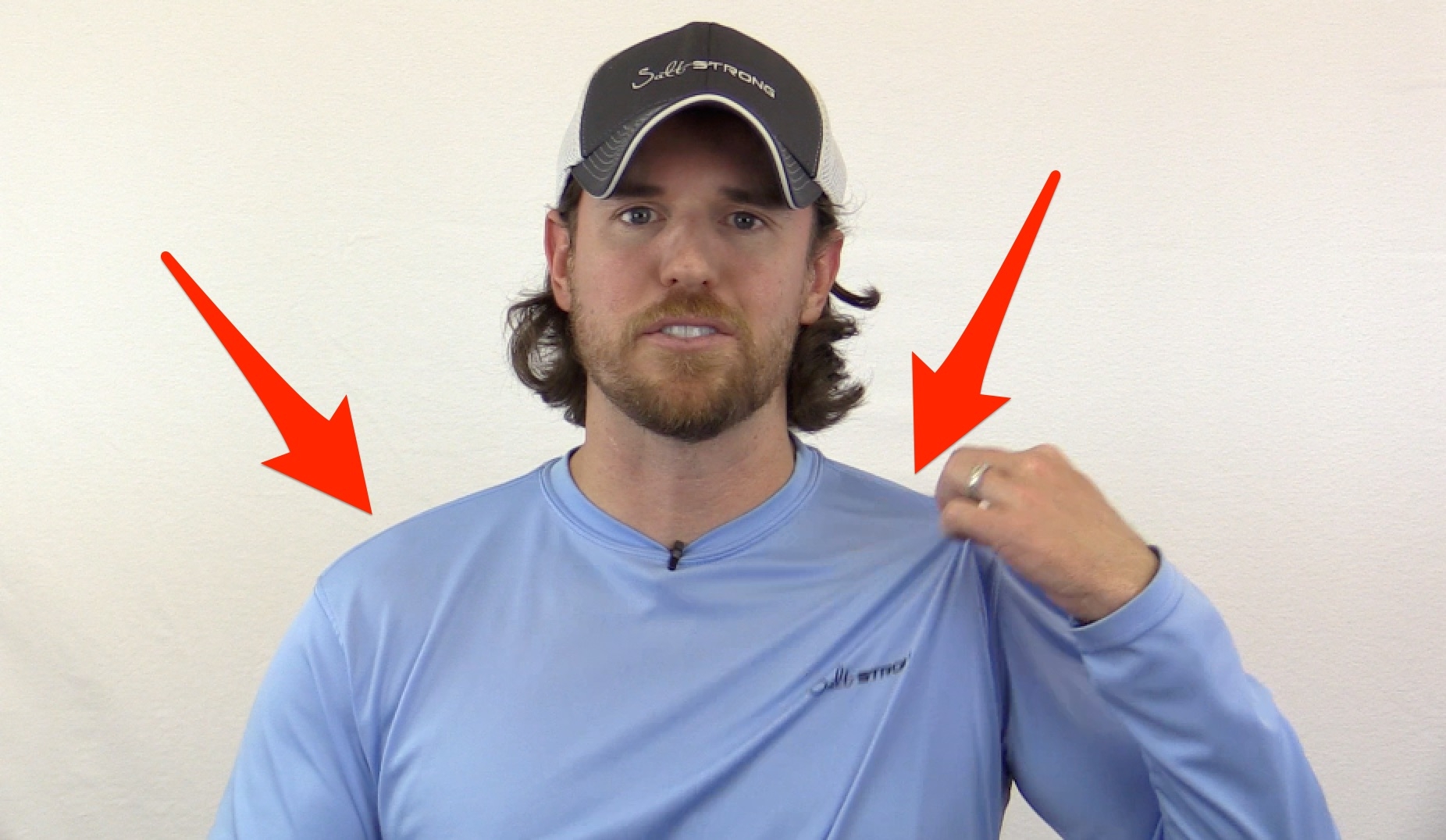
So what the heck do these performance fishing shirts mean when they say “Wicking” or “Dri Fit”?
Essentially it means that the synthetic fabric does the following:
- It drys quicker than cottton and normal polyester by increasing surface moisture migration (wicking away) and increasing evaporation time
- Helps your skin breathe by keeping the skin dry from sweat (the fabric literally wicks away the sweat and water away from the body)
- Dri-fit = Wicking (these terms and one and the same)
It is important to note that not all performance shirts were created equal in the wicking department.
For instance, the wicking technology that Salt Strong uses in all of their performance fishing shirts will wick away and evaporate on the surface many times faster than conventional polyester, and even much faster than standing wicking polyester.
Here are the results from the “Dri fit / Wicking” test that were done comparing the fabric Salt Strong uses (Pure-Tech Wicking Technology) vs standard and conventional polyester.
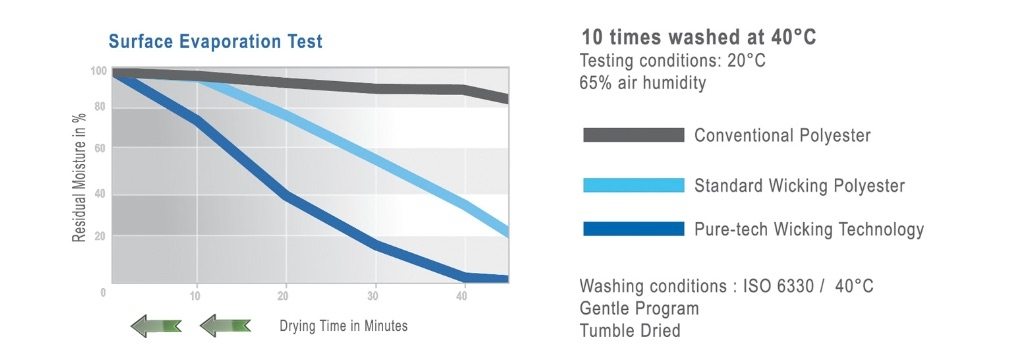
I can’t speak for all of the other brands, but make sure to do some due diligence on the wicking technology (if any) that your favorite performance brand uses.
It certainly plays a big role in these fishing shirts, especially after a long day in the hot summer sun.
8. Stain Resistant

Stain-proof: Fabric is sealed and it will not allow stains on the shirt.
Note: There are NO microfiber performance fishing shirts on the market that are 100% stain-proof (from what we’ve seen)
Stain-resistant / Stain-release: Fabric is susceptible to stains, but fends them off better than a normal cotton or plain polyester shirt would.
A few performance shirt manufacturers have announced that their shirts have “stain-release” or “stain-resistant” fabric, but it certainly doesn’t mean they won’t stain.
I have read a few comments on some of these shirts with mixed reviews. The one thing to keep in mind here is that anytime a layer of “stain-resistant” is added to any fabric (from a couch to leather seats in your car to a shirt), it will usually hinder its ability to breathe.
The takeaway: Jury is still out on this as we haven’t seen any before and after pics showing any performance shirt that is truly stain-resistant yet. Just know that if you fish in a performance shirt, you will eventually get some fish blood or guts that don’t come completely out.
9. Shirt Weight

One of the biggest misconceptions among these microfiber performance fishing shirt is with the stated “weight” of the shirt.
Just know that when you see a weight, it doesn’t mean the shirt actually weighs that much…
The shirt weight has to do with the thickness of the shirt’s fabric.
For instance, at Salt Strong, we use 4.1oz polyester (pretty lightweight), and we’ve seen everything out there from 3.9oz to 6.5oz Polyester.
The super lightweight fabric (less than 4oz polyester) is super thin, but of course you lose a bunch of your UPF rating and it will not keep you as warm during the cold morning when you are running in the boat.
On the other side of the spectrum, a heavier polyester fabric (above 5oz) is going to be a bit warmer than usual during the summer, it will usually have a high UPF (but not always as UPF isn’t just about the weight or thickness of the fabric), but it will be warmer during the cold mornings.
10. Tagless

This one is pretty simple for all consumers to understand…
Do NOT buy a microfiber performance fishing shirt if it has a tag in the back of the neck!
There is only ONE reason that any company would leave a tag in the neck of a performance fishing shirt…
Because they are too cheap to take it out and do it the right way (it costs the manufacturer extra money to take out a tag and heat seal a custom label on the back the proper way).
Now with cotton shirts, a tag is fine.
But with any shirt that you plan on wearing for multiple hours out in the sun and water, the last thing you want is a tag itching at your neck.
The Takeaway: A tag-less performance shirt is the only way to go
11. Softness

Nothing beats a soft fishing shirt!
Here is what I know on this subject:
- Most of the performance fishing shirts (the microfiber ones) are all pretty soft
- Some of them are definitely softer than others depending on the fabric that is used
- At the end of the day, this will come down to personal preference as there is no way to rank these shirts based on softness
The takeaway: Try out different shirts and see which one is the softest to you.
At places like Salt Strong, there is a 30-Day Guarantee Challenge in place for you to wear the shirt for a full 30 days, and if you don’t think it is the softest, best performance shirt for the money, you can send it back with no questions asked for a full refund (and they even cover the shipping).
Click here to learn more about the Salt Strong 30-Day Challenge.
12. Colors & Designs
Back in the day when performance fishing shirts first hit the scene, there were only a few colors to choose from…
But today, with pretty much every fishing apparel company offering these popular fishing shirts, the choices are almost unlimited in terms of the colors and patterns you can find.
We’ve seen everything from the pastels to camo to even fish scales on the sleeves!
Our personal opinion is that some of the shirts are so over the top with the design and colors that they look like they belong in a circus, but I guess some anglers must like them because we keep seeing advertisements out there for some of them…
But at any rate, it all comes down to personal preference.
Certainly the fish aren’t going to bite any more (or harder) because you have a wild rainbow design of color vs a simple looking shirt.
When selecting a performance fishing shirt, I always like to ask myself this question…
“Which shirt would Ernest Hemingway wear?”
13. Short Sleeve vs Long Sleeve
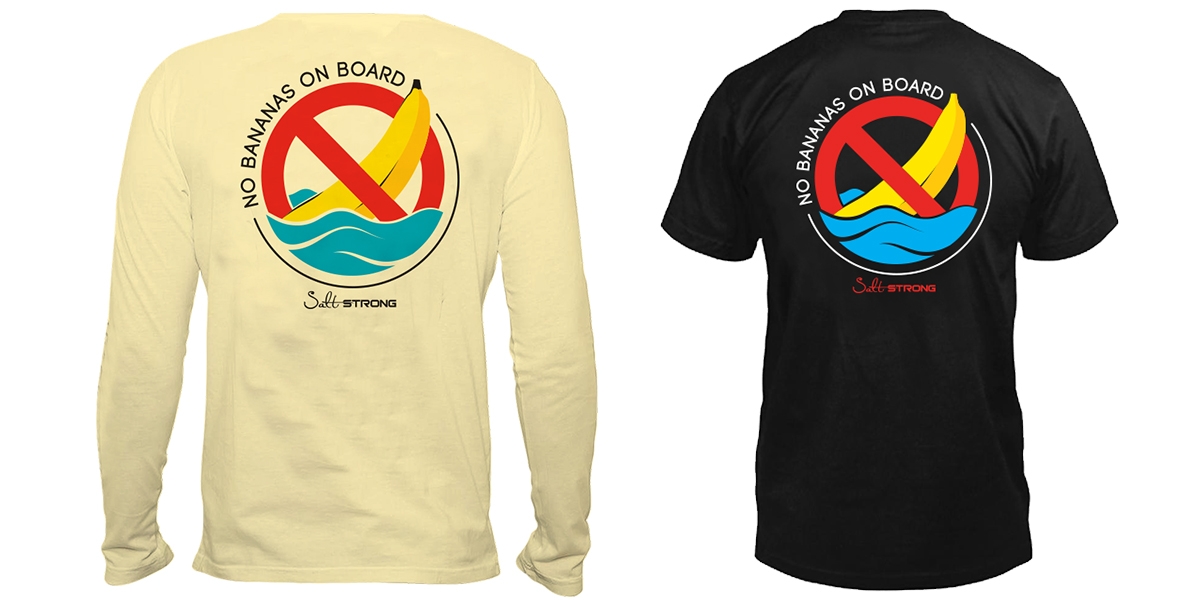
If you have spent any time shopping for these microfiber performance fishing shirts, then you have probably noticed that the majority of them are long-sleeve.
Why?
Mostly because so many anglers (and manufacturers) have wisened up to the fact that we need to protect ourselves from the sun while out fishing.
Skin cancer kills 10,000 people every year, and many of them are anglers that have spent way too much time in the sun without proper protection.
I personally had a fight with skin cancer (the real deal melanoma) that started right where my forearm meets my bicep. Had I been wearing long sleeves as a teenager, I most likely never would have had to go through my cancer ordeal.
Related Story: 5 Tips For Anglers To Avoid Dying From Skin Cancer
Now that doesn’t mean you won’t see some short-sleeve dri-fit performance shirts out there (especially ones made for other non-fishing sports), but we highly recommend going long sleeve every time.
The long-sleeve shirts don’t cost that much more than short sleeve, they actually keep your skin and body cooler by not having exposure to the sun, and you can always roll up the sleeves if you really feel the need to get some sun on your arms.
Takeaway: You are usually always better off going with the long-sleeve version of a performance fishing shirt
14. How Long Should A Performance Shirt Last?

So you spend anywhere from $25 t0 $60 on a microfiber performance fishing shirt and now you want to know how long it will last before you have to buy another one…
I wish that I could tell you these shirts will last decades, but sadly that isn’t the case (unless you never wear it, but that kind of defeats the purpose of buying it in the first place).
As you can imagine, the longevity of these fishing shirts will depend on the following variables:
- How often you wear it
- How often you wash it
- How much sun and saltwater exposure it gets
Sun and saltwater will slowly weaken any fabric, but the good news is that most of the manufacturers of these performance shirts are using top quality synthetic polyester that should last a long time.
Ideally, you will have more than one performance shirt, and by rotating a few of them in the mix, these shirts will last a solid couple of years for the average weekend warrior.
And if you are fishing every day, then it probably means you are either sponsored or can get some good deals direct so it won’t hurt the wallet so bad as you plow through performance shirts.
15. The Future of Performance Fishing Shirts
Fishing Hoodies have been around for a while…
However, up until recently, most of the hoodies on the market were meant for cold weather fishing.
There were foul weather hoodies and there were cotton hoodies.
No brand had really focused on a lightweight microfiber performance hoodie until recently.
Why are these gaining so much in popularity?
Well, they look cool to begin.
They provide amazing sun protection on your neck, head, and sides of your face.
They also can act as a replacement for a “Buff” or face/neck mask than some anglers hate wearing.
They also help you avoid the foggy sunglasses syndrome that “Buffs” cause, not to mention, take some extra glare from the side of your glasses to help you see better.
Check out the new Salt Strong hoodie below to get an idea of how these look, feel, fit, and cost.
We actually completely sold out in the first 10 days of taking it live, but just had a new shipment come in.
16. What To Do Next?

If you made it this far, that probably means you are in the market for a performance fishing shirt.
If so, then there is just one simple thing to do next…
Buy a shirt today!
Which one do we recommend?
Well, as you might guess, we are a bit partial to the super-soft, high-quality sun protection microfiber performance shirts from Salt Strong.
Why?
Well, here are a few reasons to buy from Salt Strong today:
- Salt Strong has cut out the middleman (they only sell direct to consumer) so they can invest in higher quality, better customer support, and over the top money-back guarantees
- Speaking of guarantees, all of the Salt Strong fishing shirts have a 30-day no questions asked money back guarantee. You are encouraged to wear it, fish in it, stink it up however you like. If for any reason you aren’t 100% satisfied that it is an amazing shirt, then send it back for a full refund (Salt Strong even pays for the shipping)
- The Salt Strong performance shirts are simple designs, yet still head-turning to start up conversations (and something that a salty angler like Ernest Hemingway would actually approve of)
- Right now they have a limited time price on our top-selling performance shirt. Check out the current price along with the customer reviews by clicking here now.
And of course, if you don’t think you are a fit for a Salt Strong performance fishing shirt, buy a different brand and let us know your experience there.
We’d love to hear from you in terms of what is most important to you when buying a performance fishing shirt.
Let us know in the comments.
Finally, we hope you got something out of this consumer guide and that you now have more confidence and consumer knowledge when you go to check out performance fishing shirts.
And if we left anything out, please let us know so we can address it.
Fish On!
P.S. – If you think your angler friends or fishing networks would like to see this, please Tag them or Share this with them. Thank You.
[shopify embed_type=”collection” shop=”salt-strong.myshopify.com” product_handle=”performance-shirts”]
Related categories:
STOP WASTING TIME ON THE WATER!
Do what the “SMART ANGLERS” are doing and join the Insider Club.
Here’s what you’ll receive today when you join:
- Weekly fishing reports and TRENDS revealing exactly where you should fish every trip
- Weekly “spot dissection” videos that walk you through all the best spots in your area
- Exclusive fishing tips from the PROS you can’t find anywhere else
- Everything you need to start catching fish more consistently (regardless if you fish out of a boat, kayak, or land).


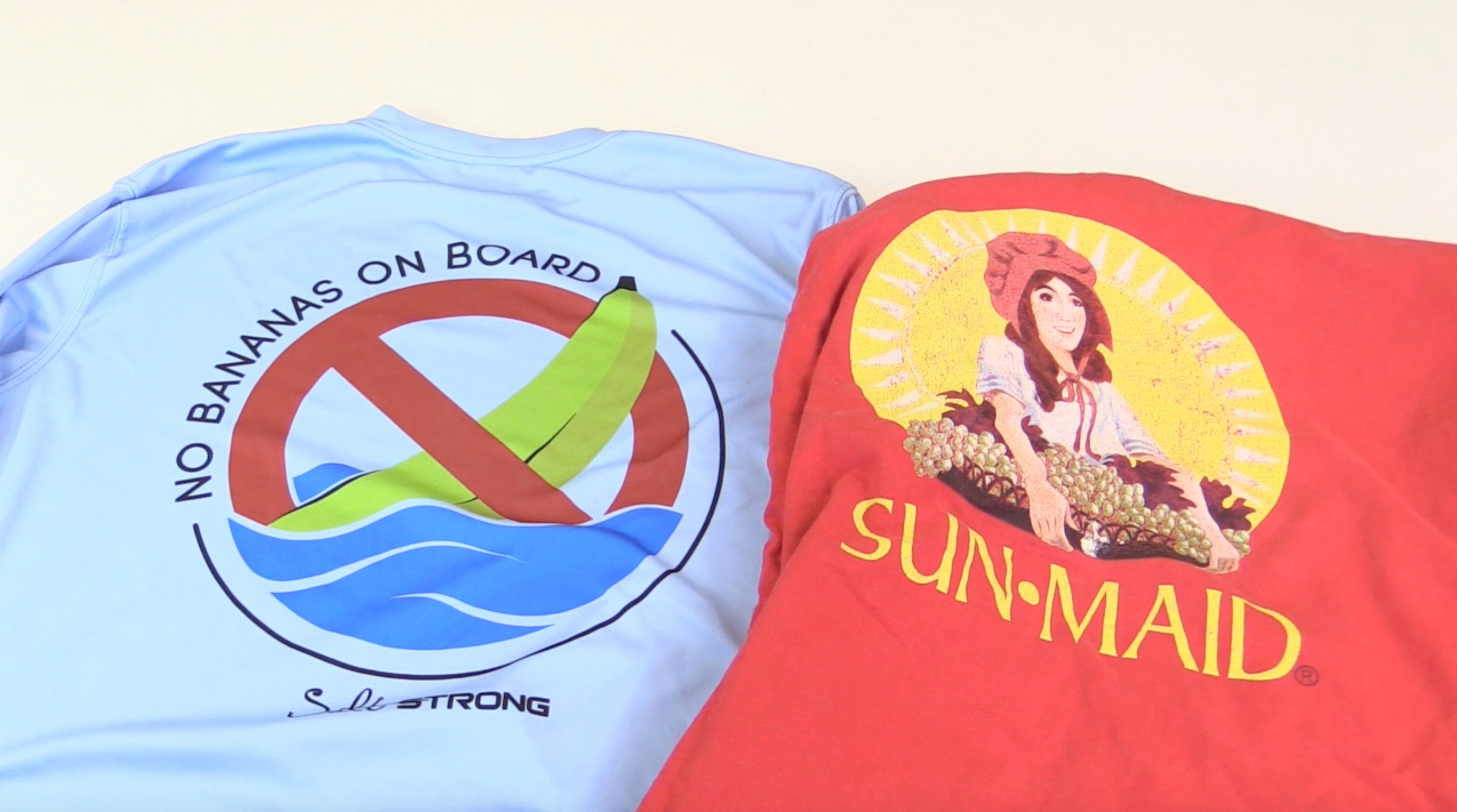










Where are Salt Strong Shirts made? Must have missed that in all the info you put out.
yes i like it.. this is the 1st time i saw this type of shirts
I enjoyed the discussion on fishing shirts. I have not seen anyone address the COOLNESS or breathability of shirts. Some shirts I have are like wearing plastic trash bags! Any suggestions?
Going to get an xl white hoodie for my birthday. Nov. 6. After that i’m going to buy my buddy one. If there’s a sale on these, i’d appreciate any hints. Thanks, neil
I WOULD REALLY LIKE TO PURCHASE SALT STRONG FISHING SHIRTS, BUT FOR THE LIFE OF ME I CAN NOT FIND THEM LISTED ANYWHERE…..
PLZ HELP IM LOSING IT BROTHER!!!!! SALT STRONG ….FISH STRONG
OH YEA……FLOUNDERS NAME….MATTIE..!!!
Hey Lee,
We only have the shirts available at certain times of the year for our Insider fishing club members (for instance, this Thursday we’ll have a 4-day sale where everything is 30-40% off). STay tuned.
Everything I need to know about making a smart purchase